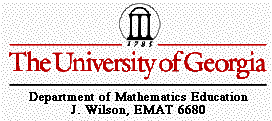


construct a circle tangent to the two circles with one point
of tangency being the designated point.
Draw a line through the given point and the center of the circle
containing the point. Use the radius of the other circle to construct
a congruent circle with its center at the given point.

Construct a segment from the center of the smaller circle to the point of intersection (outside of the larger circle) of the congruent circle and the line through the given point. Draw its perpendicular bisector.

The center of the tangent circle is the point of intersection, J, of the perpendicular bisector and the line through the given point. Now, we can construct the tangent circle with one point of tangency being the given point.


Now, students can move the given point to see other circles
tangent to the two given circles. This observation can be made
by animating the point around the circle on which it lies and
tracing the tangent circle.

Here is the locus of the centers of the tangent circles.

Explore these ideas with two given circles of different relationships. What if ...

Notice that there are tangent circles inside the smaller given
circle.

The given circles are disjoint?
The given circles are congruent?



The given circles are tangent to each another?

Is there a 'gap' in the ellipse? If so, why?